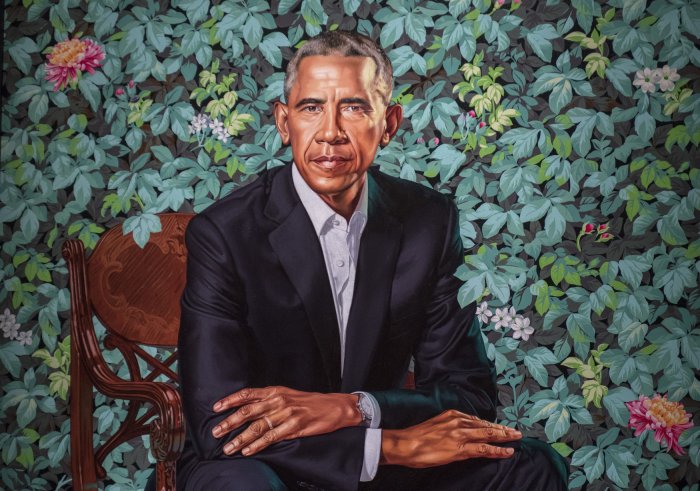
Feb. 14 (UPI) — The Obamas unveiled their official portraits Monday in Washington, D.C., and as with any artistic endeavor that bucks tradition — especially one so austere as the U.S. presidency — the paintings were greeted with mixed reaction.
The paintings were finalized, framed and hung in the Smithsonian National Portrait Gallery some four months after former President Barack Obama and former first lady Michelle Obama revealed the artists they selected for the job. It gave art experts, supporters and critics plenty of time to prognosticate about what sort of images would immortalize the nation’s 44th president and his wife.
One thing was immediately clear: Kehinde Wiley and Amy Sherald’s artworks would be unlike any presidential and first lady portraits that came before.
Both artists are celebrated for their use of color. Wiley, who painted the president’s portrait, is known for depicting young black men in poses mimicking those from more famous works of art. They are positioned before brightly colored, patterned backgrounds. Barack Obama, himself, sits before a veritable tapestry of kelly green leaves with a few bursts of color from flowers rich in symbolism — African blue lilies for his Kenyan heritage, jasmine for his birthplace of Hawaii and chrysanthemums, the official flower of Chicago.
Sherald has a different take on color, often contrasting the grayscale skin tones and patterned clothing of her subjects with a monotone shock of color on the background. She sometimes uses pattern in the background of her paintings, but in the case of Michelle Obama’s portrait, she used a flat robin’s egg blue, throwing the figure of the former first lady in sharp relief.
Put these two paintings in the same room with other official presidential portraits and there’s a noticeable difference — one many people noticed after Monday’s unveiling.
Most previous presidential portrait painters kept to a common color scheme, rich in neutrals — black, brown, grey or beige with perhaps a shock of red tieor blue sky here and there.
One Twitter user noted the shocking difference in color scheme, indicating she wasn’t a fan of the former president so strongly breaking with the tradition of his office.
“The absurdity of Obama’s portrait is beyond parody,” user @GotWesties wrote.
“My real takeaway is that the portrait really does defer to this aura that Obama has, of both being very much a representative black man but also one who, with those wonderful hand gestures, has a side that is sensitive, that is empathetic, that is loving, that is caring. I think Wiley actually stretched to do something quite special, and it’s a real eye-opener,” Powell said.

And while the color scheme may be provocative, the posing isn’t all that unusual. Paul Staiti, professor at Mount Holyoke and author of Of Arms and Artists: The American Revolution through Painters’ Eyes, said the painting mimics one of President Abraham Lincoln, in which the 16th president leans forward on the edge of a decoratively carved armchair, pensive in thought.
The Lincoln painting by George P.A. Healy is located in the State Dining Room of the White House and is regularly visible in many photographs.
“Wiley’s portrait of Obama, appropriately unveiled on Lincoln’s birthday, channels the Healy painting, especially the old-style chair, the simple setting, the alert pose and thoughtful expression,” Staiti wrote in an article in The Washington Post. “Wiley’s Obama, however, is not lost in thought like Healy’s Lincoln, but instead looks outward and leans slightly forward, as if waiting for your next word. And instead of the darkness that threatens to engulf Lincoln, Wiley substituted an effusion of plants.”
Perhaps the most controversial of the two paintings, though, is that of the former first lady. Tweets upon tweets lambasted the portrait, questioning the choice of skin color and whether it even looks like Michelle Obama at all.

Holland Cotter, co-chief art critic of The New York Times, wrote that Michelle Obama’s face in the painting “could be almost anyone’s face, like a model’s face in a fashion spread.”
“To be honest, I was anticipating — hoping for — a bolder, more incisive image of the strong-voiced person I imagine this former first lady to be.”
Powell defended the representation, saying it’s typical of Sherald’s style not to paint with “photographic likeness.”
“I think when you look at the gesture, when you look at the pose, when you feel the whole coolness of the piece, to me that is Michelle Obama. I think she nailed it in that regard,” he said.
Still others took issue with Sherald choosing the paint Michelle Obama’s skin in grayscale with a hint of sepia instead of the rich, brown tones of her actual skin tone.
Again, it’s a decision the Baltimore artist typically makes in her portraiture.
It’s “a way for me to subversively comment about race without feeling as though I’m excluding the viewer,” she told The Baltimore Sun earlier this month.
For their part, the Obamas seemed pleased with the bold portraits, with the former president thanking Sherald for capturing the “hotness” of his wife.
“Amy, I want to thank you for so spectacularly capturing the grace and beauty and the intelligence and charm and hotness of the woman that I love,” he said.
Reacting to his own portrait, Obama quipped, “that’s pretty sharp!”
Michelle Obama said she was “overwhelmed to say the least” by the more-than life-size painting. She said she thought about the impact it would have on “girls and girls of color.”
“They will see an image of someone who looks like them hanging on the walls of this great American institution,” she said. “And I know the kind of impact that will have on their lives because I was one of those girls.”






